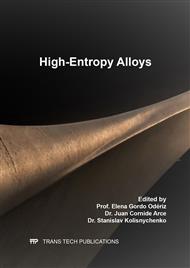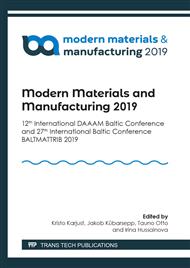p.83
p.89
p.97
p.103
p.109
p.116
p.125
p.131
p.136
Annealing Effects on the Microstructure and Properties of Vanadium and Molybdenum Rich FCC High Entropy Alloy
Abstract:
In the past decade, research into High Entropy alloys (HEAs) have gained significant attention due to their outstanding properties and approach to design alloys for high temperature applications. Strengthening of face centered cubic (FCC) based HEAs, by addition of intermetallic phase or precipitate forming elements is a very captivating direction of alloy designing for high temperature structural applications. However, the knowledge regarding the influence of intermetallic phases on the properties of FCC HEAs is rare. The current study focuses on annealing effects on the microstructure of Cr20Co20Fe25Ni25V5Mo5 (at. %) alloy, this alloy was synthesized using induction melting, and was homogenized at 1200 °C for 12h. X-ray diffraction analysis indicated that the principle phase was (FCC) identified. Scanning electron microscopy (SEM) together with Energy Dispersion X-ray Spectroscopy (EDS) showed that there is an additional phases that is Mo-rich. In order to understand the effect of the high temperature annealing on phase stability, the homogenized samples were annealed at 700 °C, 800 °C, 900 °C, 1000 °C each for 6h and quenched. The annealing treatments had considerable effect on the crystal structure and the elemental distribution. The Mo-rich phase is precipitated at the grain boundaries at all temperatures. Additionally, at 1000 °C annealing temperature Mo-rich phase had precipitated inside the grains. The lower annealing temperatures inhibited diffusion of Mo, which restricted the Mo-rich phase formation. Additionally, the hardness is increased to 195 HV at 1000 °C due precipitation hardening. At other annealing temperatures the hardness is reduced to 145 – 158 HV.
Info:
Periodical:
Pages:
109-115
Citation:
Online since:
April 2019
Authors:
Price:
Сopyright:
© 2019 Trans Tech Publications Ltd. All Rights Reserved
Share:
Citation:



